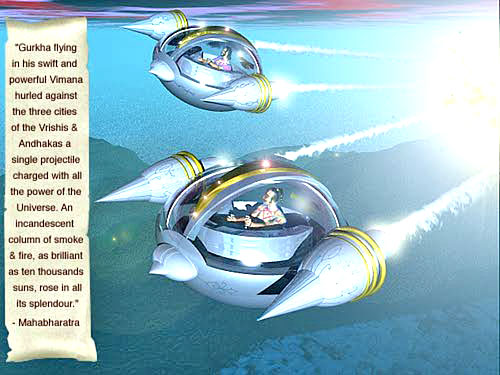|
by The Hindu Staff Reporter
January 2005
from Rense Website
TIRUPATI --
It is this feeling that one would get after listening to a lecture on 'High Technology in Ancient Sanskrit Literature' by Mr. C. S. R. Prabhu, senior scientist, NIC, Hyderabad, on Thursday as part of the three- day Indo-Nepal Sanskrit Conference, currently underway at the Rashtriya Sanskrit Vidyapeetha here.
Mr. Prabhu, quoting extensively from ancient texts, stressed that the pre-Mahabharata period was an age of high technology, which was ignored in the Medieval period due to reasons not known. He quoted from the texts of a great scholar, Subbaraya Sastry, who, in a state of yogic trance, is said to have orally dictated the spacecraft technology in a period somewhere between 1875 and 1919, which was recorded by his disciples. The text, a copy of which is still in Nepal's Royal Library, contained technical details on assembling, fabricating and erecting a spacecraft, the metals, semi-conductors, advanced alloys used and other minute aeronautical information. Though quite difficult to be believed on the face of it, the fact that this technology did not exist anywhere in the world - not even in America and Europe - in the mentioned period, makes it hard for one to disbelieve. 
Artwork by James Neff
The technical information given in Sastry's texts was as minute, precise and clear, as if it were a 'Make your own spacecraft' or a 'Spacecraft technology in 30 days' except for the Sanskrit language used, which was very much archaic and obsolete, Mr. Prabhu said. On a tip on making an alloy, the text said 'Krishnaseesam Chanjanikam Vajrathundam samamsathaha' from which the real meaning of 'Vajrathundam' (used in that context), could not be found in any contemporary Sanskrit dictionary.
To further strengthen his claim, he said there were wall paintings in some forts in Rajasthan depicting the use of rockets in Mughal warfare and even by Tipu Sultan of Mysore. Another interesting fact he gave was that the spacecraft could become invisible on its own. The lead alloy (Thamogarbha loha) used in making the body of the spacecraft would absorb light around it in a photo chemical reaction that would make it disappear.
On testing the Krishna seesa metal mentioned in the formula in the laboratory of Birla Institute of Science, Hyderabad, Mr. Prabhu found the metal absorbing 78 per cent of laser light, which means, any other light could be easily absorbed, giving ample proof that there existed a technology to make things invisible. Also the use of an alloy of copper, zinc and lead made the spacecraft's body resist corrosion by 1000 times over that of the current levels. Using Ararakamra material for the axle and wheels had made it possible for taking 'U' turns and serpentine movements. An astonishing fact is that the Ararakamra metal was an alloy of copper, zinc, lead and iron, the combination of which is impossible, according to modern metallurgy. Technically, the ''Young's modulus'' of this metal is said to be higher than that of steel, making it stronger. As the spacecraft had to be capable of resisting high temperature, on re-entering our atmosphere from the outer space, its body was made with a metal called 'Raja Loha'. Its special feature was that apart from resisting heat, it converted light from lightnings into energy. To crosscheck all these details, there were no furnaces available in Hyderabad to melt metals at a high temperature of 2500 degrees celcius, Mr. Prabhu lamented. Another hitch came into his research in the form of the 'energy' used.
Later he found out to his bewilderment that it was a kind of 'nuclear power' that was used in those days.
He even spoke on 'Tripura Vimana' that was used to travel in space, water and on land, by using the metal 'Trinetra loha'. Mr. Prabhu said he had submitted the model and some more information on the 'super metal' to the Indian Metal Society Conference and further claimed that the advisor to the government on scientific affairs Dr. A. P. J. Abdul Kalam too had asked him to bring the design of the plane.
A committee which was appointed by Indian Institute of Science to investigate into it, declared Sastry's texts as 'fraud', but Mr. Prabhu reasons that the descriptions mentioned in the ancient texts were perhaps too advanced to believe, making the committee to hastily come to the conclusion. He wanted a national level effort to prove that the so called 'myths' were in fact, scientific formulae on advanced technology. He said he had proposed a project called 'Bharadwaja Institute of Vedic Science and Technology', the objective of which was to derive, decipher and reproduce advanced methodologies and processes from Vedic and post-Vedic Sanskrit texts, for which he sought government's support. |
Saturday, April 6, 2013
ancient spacecraft tech
Subscribe to:
Post Comments (Atom)

No comments:
Post a Comment